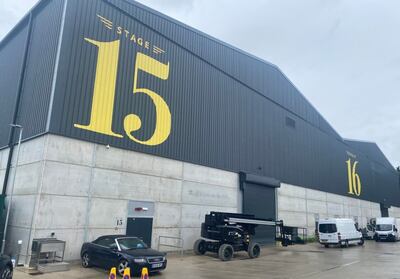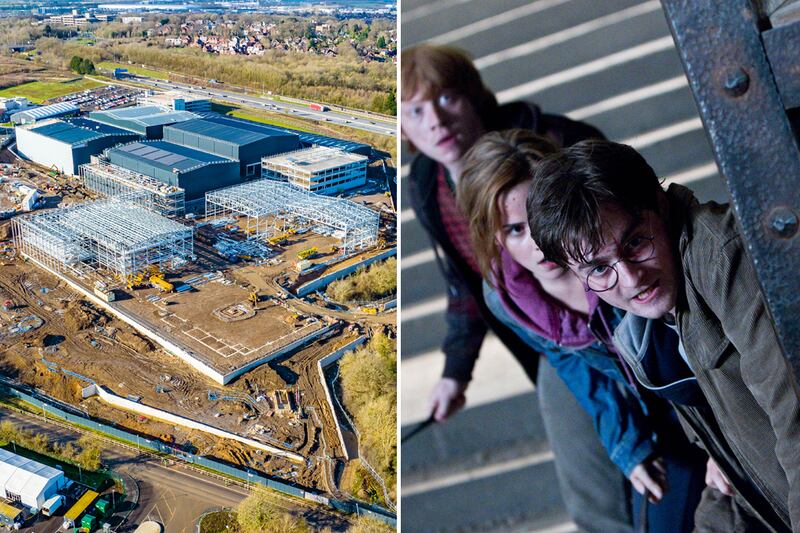Just south of England's M4 motorway, 64km west of London, a cluster of huge warehouse-like structures are emerging from the earth as a phalanx of 450 workers in high viz jackets and a legion of diggers, bulldozers and lorries crawl over the terrain..
This hive of activity is the latest development in Britain’s £6.3 billion ($7.79 billion) boom in film sets and high-end television (HETV) studios.
Shinfield Studios, near Reading in Berkshire, is the largest bespoke complex currently being built in the United Kingdom. It will be a new powerhouse of film, television production and innovation.
“Shinfield will make a quantum difference to the number of projects able to film in the UK, which will generate significant inward investment to the UK and create economic benefits to the local community,” says managing director Nick Smith.
When finished, expected completion is December, it will have 18 state-of-the-art stages covering more than 26 hectares and provide almost 93,000 square metres of production space. The stages range in size from 1,858 square metres to 3,716 square metres.
Huge acoustic sheds with walls a metre thick for sound insulation and 1.85m square sliding doors tower over actors and technicians. Four were finished last year and have already been used by Netflix for Bridgerton 3. The Acolyte, the much-anticipated Star Wars prequel, is now being made there. In another stage, a set more than 15m tall is being built for a film. It reaches to the gantry from where huge lighting rigs will hang.

Costing £300 million, Shinfield is now part of the second largest entertainment sector in the world behind north America. In 2019 it eclipsed the UK car industry in size and helped to keep Britain out of recession.
Shinfield itself will generate an estimated £600 million a year for the UK economy and 3,000 jobs locally.
That Britain is seen as a great place to work is evident in the figures released last month by the British Film Commission.
They showed that in 2022 the film and HETV sector was worth £6.3 billion in inward investment. Since the Covid-19 pandemic the sector has been growing at 6 per cent per year.
From Sony to Disney, from Paramount to Warner Bros and Universal, the industry’s biggest players are doubling down on Britain.
And the industry in the UK is responding to satisfy that demand. For instance, in February Pinewood, home to James Bond and 007, announced an expansion that will make it the largest studio complex in the world.
Five years ago there was a shortage totalling 185,806 square metres. Britain now has 464,515 square metres operational, with another 325,160 square metres coming on stream over the next three years.

“We're probably building more studio space than anyone else in the world right now, “ says Adrian Wootton, the chief executive of the British Film Commission. “And we are bigger than Europe combined.
”We talk about the special relationship with the US. Actually the biggest manifestation of that isn't to do with military or politics. It is cinema, film and television.”
The trigger for the explosive growth boom was the release of the eight Harry Potter films between 2001 and 2011.
Highly attractive tax breaks introduced by government in 2007 for film and in 2013 which embraced HETV, turbocharged the process. HETV is defined by a budget of at least £1 million per hour.
Although reconfigured in the recent budget, the tax incentives still equate to a 25 per cent credit on the costs of production.
The Covid lockdown meant most available content was largely consumed.
In short, the cupboard was bare and stock needed replenishing, hence the explosion in productions and studio development over the past five years, aided and abetted by streamers, Apple, Amazon and Netflix.
Tax is not the only attraction. London itself is a huge draw, which explains the number of studios that sweep in an arc to the north west and west of the capital.

“From the American point of view Heathrow is London. If a studio and a production are within an hour of Claridge's [Hotel] that’s ideal, “ says Jason Lebidineuse, head of the film studios arm of the architects Scott Brownrigg, whose team designed Shinfield.
London and the South-East are not the only beneficiaries. On the back of the boom, production clusters around conurbations in Britain and Northern Ireland have emerged. Wootton says the industry embraced levelling up before the term became fashionable.
“The democratisation of the demography of the UK in film and television is quite a remarkable story,” he says, citing Game of Thrones in Northern Ireland, Outlander in Scotland and His Dark Materials in Wales.
Wootton also points to what he calls soft power that Britain can utilise.
“We have the largest pool of English-language crew and cast anywhere outside of North America, and talent in front and behind the camera.
“Soft power includes the language, time zone, insurance, health and safety, and other related services like legal and accountancy.”
Finding sites is hard. The land has to be flat, off the flood plain, secure and with massive power available. Planning permission is usually straightforward.

“Councils love it because it’s not just another housing estate or a business park,“Lebidineuse says. " A film studio is a great draw and also brings employment to the local economy. Shinfield is expected to generate 3,000 local jobs.”
Walking around the Shinfield site, which started life as a science park that failed to take off, it is difficult to overstate the logistical complexities of the project and the speed with which it is taking shape.
The actual building phase, involving thousands of tonnes of steel, cladding and roofing, will have taken little more than two years. The developers, Shadowbox Studios, have taken a 199-year lease from the freeholder, the University of Reading, attracted by the fact that a successful franchise can run for up to five years.
Shadow Box, who have studios in Atalanta and Los Angeles, are in turn backed by the American company Commonwealth Asset Management and Silver Lake, the private equity giant.
Speed to market is key. “The biggest thing you have got here is working out how fast you can get them up and running,” Lebidineuse says. “That is vital. Time is money. We are challenging the modern methods of construction so that we could create a long-term future for the film industry.”
Dean Horne, head of studio operations for Curo Constructions, the main building contractor, has been in the industry for 20 years.
“The last 10 years have been crazy,” he said. “I haven’t seen anything like it. It has ramped up year on year. When fully completed, the studios will be able to handle three or four large productions, with back-up office and workshop space.”

The big question is, can it be sustained? There is already an estimated shortfall of 20,000 skilled staff in the industry, which employs 122,000 in full-time work. Thousands more work in a freelance capacity.
The industry has in part become a victim of its own success. Crew shortages are not an issue that is unique to Britain, but it is more acute because of the sheer volume of work here.
“It is an issue,” Wootton admits. “We've been seeing that in the last couple of years. We haven't lost any productions to skill shortages, but it has stretched our crewing. We know we need a lot more people,”
But the industry is coming together to address the issue, he says, although it will take time for the benefits to filter through. A task force with stakeholders such as the BFC, the BFI, the Production Guild, and Pact, together with all the streamers and film producers, is hammering out a new workforce plan which should be agreed this summer. “That’s looking at how we turbo-charge training that the industry absolutely wants,” he says.
“The BFI is redeploying its lottery funding to help stimulate and create new regional training clusters all over the UK, which can work with local authorities and schools and colleges.
“It’s a big challenge to deal with it. One aspect is to try to educate the educators that there are these incredibly highly paid jobs out there. If you get the right skills, the right training, there are fantastic jobs.
“We have the opportunity to change a whole generation of young people's lives with opportunities in the film industry if we get it right. “
Initiatives will not produce instant results but the right foundations are being laid. In January the University of Westminster pioneered a master's programme that will launch students into careers in film and television distribution, management and business. The new course aims to prepare students to work in this international industry. The University of Reading is developing courses in tandem with Shinfield in what is known as Cine Valley.
Another issue is whether the pace of studio development can be sustained and whether saturation point will soon be reached.
“The demand is such that there will not be a saturation point at least in the foreseeable future,” Wotton continues. "The pace of growth might slow, but it's not because the appetite for content has dropped away.
“What's really exciting is that the overwhelming majority of the hundreds of millions of dollars being invested is by private companies. That indicates just what confidence they have in the film and television economy in the UK.
“We're determined to remain competitive, we're determined to reap the benefits of this global demand. This is too good for the British economy to do anything other than keep on working as hard as we can to sustain it.“
That is something Shinfield will be delighted to hear.






